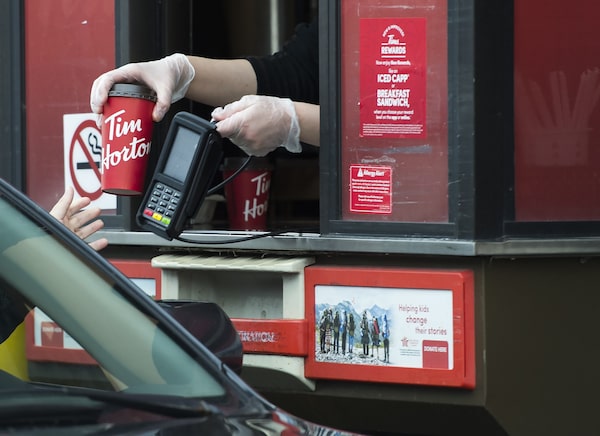
A Tim Hortons employee hands out coffee from a drive-through window to a customer in Mississauga, Ont.Nathan Denette/The Canadian Press
Tim Hortons and Burger King parent company Restaurant Brands International Inc. QSR-T reported increasing sales and profits in its latest quarter, as traffic to its restaurants increased and the company raised prices to offset higher costs of commodities, labour and energy.
The Toronto-based company, which also owns Popeyes Louisiana Kitchen and Firehouse Subs, reported on Thursday that its net income grew in the first quarter to US$277-million or 61 cents a share, compared with US$270-million or 59 cents in the same period the prior year.
Its overall revenue grew by 9.6 per cent year over year, to US$1.49-billion, beating analysts’ estimates.
Other fast-food chains, such as McDonald’s Corp. and Chipotle Mexican Grill Inc., also recently reported quarterly sales growth as they passed on higher costs in the form of menu price increases.
Restaurant Brands attributed part of its revenue growth at Tim Hortons to “commodity prices passed on to franchisees” – a practice that has been a sticking point in recent months, as a group representing some restaurant owners has raised concerns about profitability.
In February, the company disclosed that franchisee profitability had fallen since 2018: The average Tim Hortons location made $220,000 in earnings before interest, taxes, depreciation and amortization in 2022, down from $320,000 in 2018. On Thursday, chief executive officer Joshua Kobza said that franchisee profitability has been improving at both Tim Hortons and Burger King.
“Importantly, our topline results – coupled with moderation in overall cost inflation – helped drive improvements in restaurant level profitability this quarter,” Mr. Kobza said in a conference call with analysts to discuss the results, adding that Restaurant Brands expects improvements to continue this year. The company did not provide updated profitability numbers for the quarter, but has committed to reporting on average franchisee profitability on an annual basis.
Executive chair Patrick Doyle – a former Domino’s Pizza CEO who led a turnaround at that chain, and joined Restaurant Brands in November – noted on the call that the company is giving greater weight to franchisee profitability in its incentive compensation for employees. He also reiterated a message he has sent publicly before, that franchisees who are not “all in” on the company’s plans will leave the Restaurant Brands system.
“There simply is no room for franchisees who are not willing – or able – to work hard to operate restaurants that are better than the system average over the long-term. But we’re talking about a small number here,” Mr. Doyle said.
In Canada, Tim Hortons has benefitted from people returning to the office in greater numbers – a significant factor driving its breakfast and morning coffee sales. The chain has also been increasing sales of food in the afternoon and evening to adapt to changing behaviours. Overall mobility in Canada is improving, but is still far short of 2019 levels, chief corporate officer Duncan Fulton said in an interview.
“Particularly with certain changes in working from home that might be permanent, you can’t just rely on a breakfast business,” he said. “We’re pleased to see great growth in breakfast, which indicates morning traffic coming back, but also even stronger growth year over year in lunch and dinner.”
The company said that sales increased at all its restaurant chains in the three months ended March 31.
At Tim Hortons, comparable sales grew in the quarter by 13.8 per cent compared with the prior year.
Burger King, which is in the midst of a US$400-million turnaround plan called Reclaim the Flame, reported comparable sales growth of 10.8 per cent in the quarter. The company is boosting spending on advertising, digital upgrades, restaurant remodels and relocations, in-store technology and better equipment, but is still in the early stages of the program it announced last year, having spent US$45-million so far, as of the end of the first quarter.
Comparable sales also grew by 5.6 per cent at Popeyes and by 6.1 per cent at Firehouse Subs.